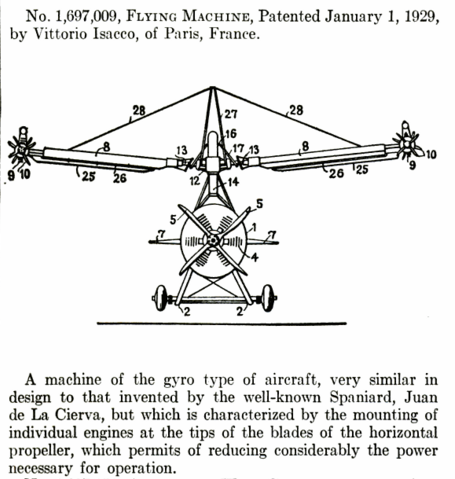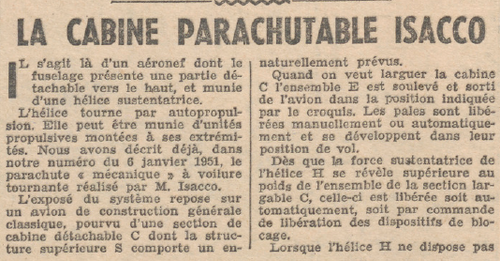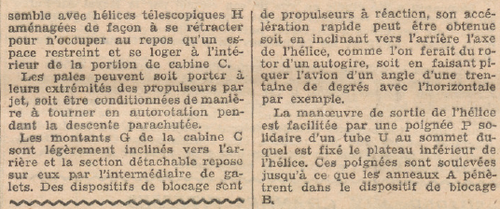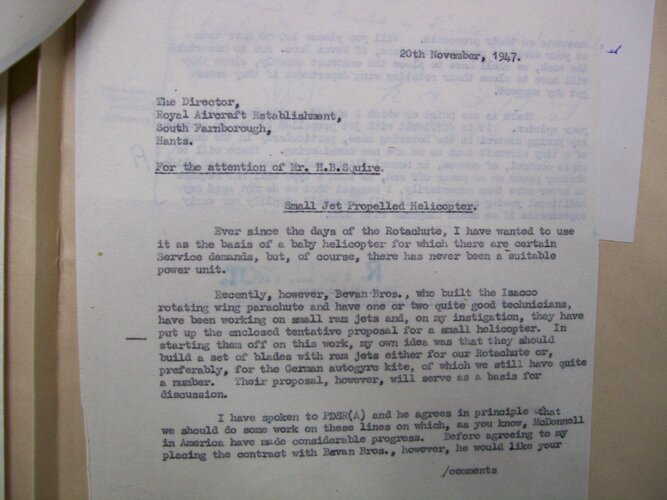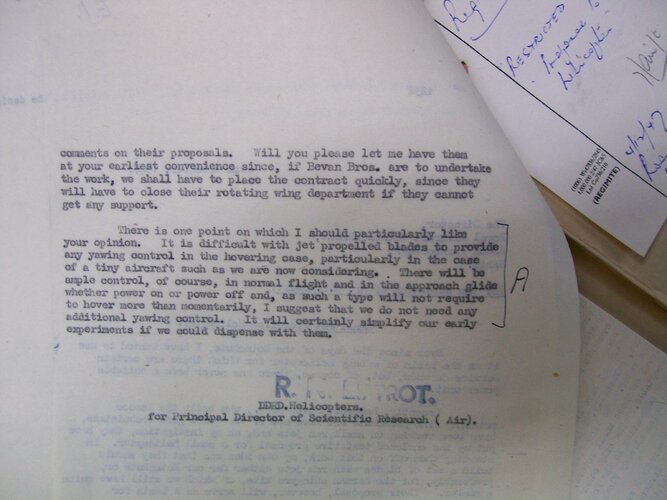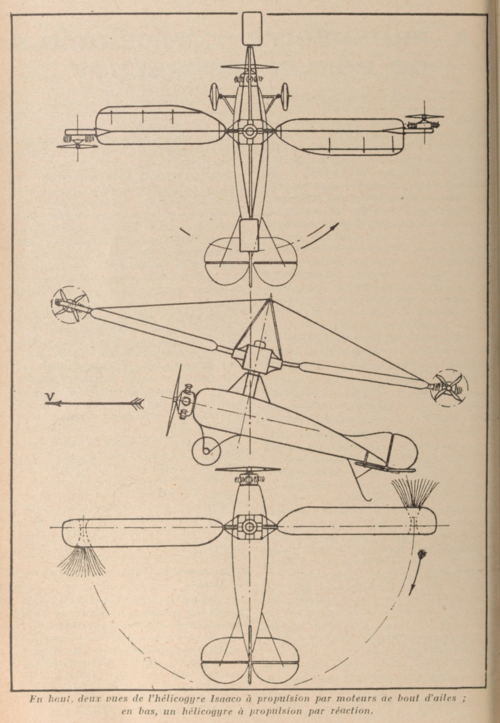You are using an out of date browser. It may not display this or other websites correctly.
You should upgrade or use an alternative browser.
You should upgrade or use an alternative browser.
Isacco Jet-Propelled Helicogyro
- Thread starter hesham
- Start date
- Joined
- 26 May 2006
- Messages
- 33,572
- Reaction score
- 13,701
avion ancien
The accidental peasant!
- Joined
- 6 March 2013
- Messages
- 361
- Reaction score
- 237
Arthur Ord-Hume ('British Light Aeroplanes .... 1920-1940') makes the following comment on the Isacco Helicogyro:
'The so-called 'helicogyro' was the invention of an Italian, Vittorio Iscacco. He worked beteeen 1917 and 1925 with Pateras Pescara in Argentina on the experiments with the latter's helicopter. Then Isacco hit on the idea of making a machine with a pair of rotating wings - driven by a propeller and an engine at each wingtip. Convinced of the potential of such a machine, the designer went to France where two were built in 1926. A third machine was built in Britain by S.E.Saunders. This was evaluated by the Air Ministry for a year or so: it carried the military serial number K1171. Isacco addressed the Royal Aeronautical Society in London in March of 1929 and demonstrated, like so many inventors before and since, tremendous enthusiasm and unbounded faith in his invention: a faith in which no hurdle was large enough not to be cured instantly and simply. The tests at RAE Farnborough, though, were not completed. Apart from simple technical problems like swinging four Bristol Cherub engines on a 48ft diameter rotor while trying to arrange equal lubrication for the two cylinders while fighting centrifugal force, the loads on the structure were such that the engine control wires tended to stretch. The real reasons the tests were abandoned were that they were both dangerous and alarming! Not that Isacco's idea was entirely new. A long forgotten helicopter pioneer was Louis Brennan who, at the age of 63 in 1916, was granted a patent (No. 281,735) for such a machine. Improved upon with a further patent in 1919, it was not until 1921 that Brennan was able to put his ideas into practice: he designed and built a ferocious machine in the airship hangar at Farnborough which was tried on May 16th, 1924. This lethal device had a centrally mounted 230hp engine that drove four bladed propellers at the tips of a 60ft diameter two-bladed rotor. Much later it was this same sort of idea which led to the appearance of a business called Nagler Heligiro (Parent) Company Limited during the summer of 1937. Apparently created to build a machine to the design of Bruno Nagler, a former associate of Raoul Hafner, nothing transpired under this name and the firm disappeared. In post-1939-45 war years, however, Fairey Aviation tried a variation on the idea with the Jet Gyrodyne, driving a two-bladed rotor with tip jets. The outcome was one of the most spectacularly noisy aircraft of all times.'
I don't know what became of the British Isacco Helicogyro (or, for that part, the two that were built in France). However at least two of its engines survived because Ord-Hume goes on to say that:
'Two Bristol Cherub Mk.III were installed [in the Halton HAC.III Meteor], one as a tractor, the other as a pusher, to give a total of 72hp. They had been loaned to the [Halton Aero] Club by the Air Ministry: they had earlier been installed in the experimental helicopter designed by the Italian engineer Vittorio Isacco'.
Should anyone wish to know more about the Brennan Helicopter, I would recommend them to http://sussexhistoryforum.co.uk/index.php?topic=8533.0 and https://oldmachinepress.wordpress.com/2015/01/08/brennan-helicopter/..
And finally, I'm unsure why the title to this post describes the Isacco Helicogyro as 'jet-propellled'. As far as I'm aware it only used conventional piston engines. Not until after WW2 did Fairey introduce tip jet engines to this concept.
'The so-called 'helicogyro' was the invention of an Italian, Vittorio Iscacco. He worked beteeen 1917 and 1925 with Pateras Pescara in Argentina on the experiments with the latter's helicopter. Then Isacco hit on the idea of making a machine with a pair of rotating wings - driven by a propeller and an engine at each wingtip. Convinced of the potential of such a machine, the designer went to France where two were built in 1926. A third machine was built in Britain by S.E.Saunders. This was evaluated by the Air Ministry for a year or so: it carried the military serial number K1171. Isacco addressed the Royal Aeronautical Society in London in March of 1929 and demonstrated, like so many inventors before and since, tremendous enthusiasm and unbounded faith in his invention: a faith in which no hurdle was large enough not to be cured instantly and simply. The tests at RAE Farnborough, though, were not completed. Apart from simple technical problems like swinging four Bristol Cherub engines on a 48ft diameter rotor while trying to arrange equal lubrication for the two cylinders while fighting centrifugal force, the loads on the structure were such that the engine control wires tended to stretch. The real reasons the tests were abandoned were that they were both dangerous and alarming! Not that Isacco's idea was entirely new. A long forgotten helicopter pioneer was Louis Brennan who, at the age of 63 in 1916, was granted a patent (No. 281,735) for such a machine. Improved upon with a further patent in 1919, it was not until 1921 that Brennan was able to put his ideas into practice: he designed and built a ferocious machine in the airship hangar at Farnborough which was tried on May 16th, 1924. This lethal device had a centrally mounted 230hp engine that drove four bladed propellers at the tips of a 60ft diameter two-bladed rotor. Much later it was this same sort of idea which led to the appearance of a business called Nagler Heligiro (Parent) Company Limited during the summer of 1937. Apparently created to build a machine to the design of Bruno Nagler, a former associate of Raoul Hafner, nothing transpired under this name and the firm disappeared. In post-1939-45 war years, however, Fairey Aviation tried a variation on the idea with the Jet Gyrodyne, driving a two-bladed rotor with tip jets. The outcome was one of the most spectacularly noisy aircraft of all times.'
I don't know what became of the British Isacco Helicogyro (or, for that part, the two that were built in France). However at least two of its engines survived because Ord-Hume goes on to say that:
'Two Bristol Cherub Mk.III were installed [in the Halton HAC.III Meteor], one as a tractor, the other as a pusher, to give a total of 72hp. They had been loaned to the [Halton Aero] Club by the Air Ministry: they had earlier been installed in the experimental helicopter designed by the Italian engineer Vittorio Isacco'.
Should anyone wish to know more about the Brennan Helicopter, I would recommend them to http://sussexhistoryforum.co.uk/index.php?topic=8533.0 and https://oldmachinepress.wordpress.com/2015/01/08/brennan-helicopter/..
And finally, I'm unsure why the title to this post describes the Isacco Helicogyro as 'jet-propellled'. As far as I'm aware it only used conventional piston engines. Not until after WW2 did Fairey introduce tip jet engines to this concept.
- Joined
- 6 September 2006
- Messages
- 4,620
- Reaction score
- 8,609
Bevan Brothers built Isacco's rotating-wing parachute, but it seems that it was Bevan Brother's own idea to use tip-jets. So no, I think that Sturtivant is incorrect here and the Helicogyre No.5 is a different design from that of the Bevan design, which made use of Fa.330 structures as the fuselage.
This 1947 minute outlines the brief background history.
Source: AVIA 54/768 Proposal to Build a Small Jet Powered Helicopter. Bevan Bros.
This 1947 minute outlines the brief background history.
Source: AVIA 54/768 Proposal to Build a Small Jet Powered Helicopter. Bevan Bros.
Attachments
Similar threads
-
General Development Co. twin boom heavy transport aircraft
- Started by hesham
- Replies: 41
-
Dornier 1931 Schneider Trophy Racer Projects
- Started by hesham
- Replies: 39
-
Blackburn « Sydney » and « Nile » flying boats
- Started by hesham
- Replies: 25
-
Blackburn C.A.11A three-engined high-wing monoplane
- Started by hesham
- Replies: 2
-


